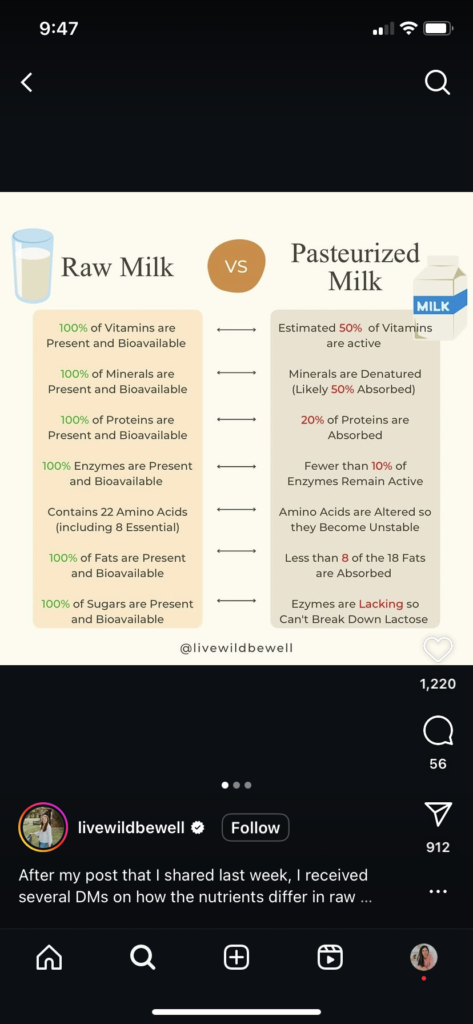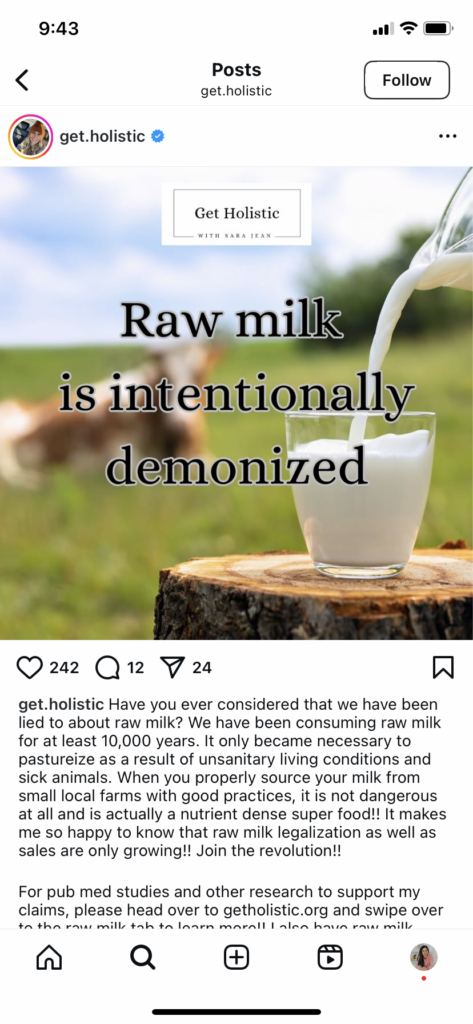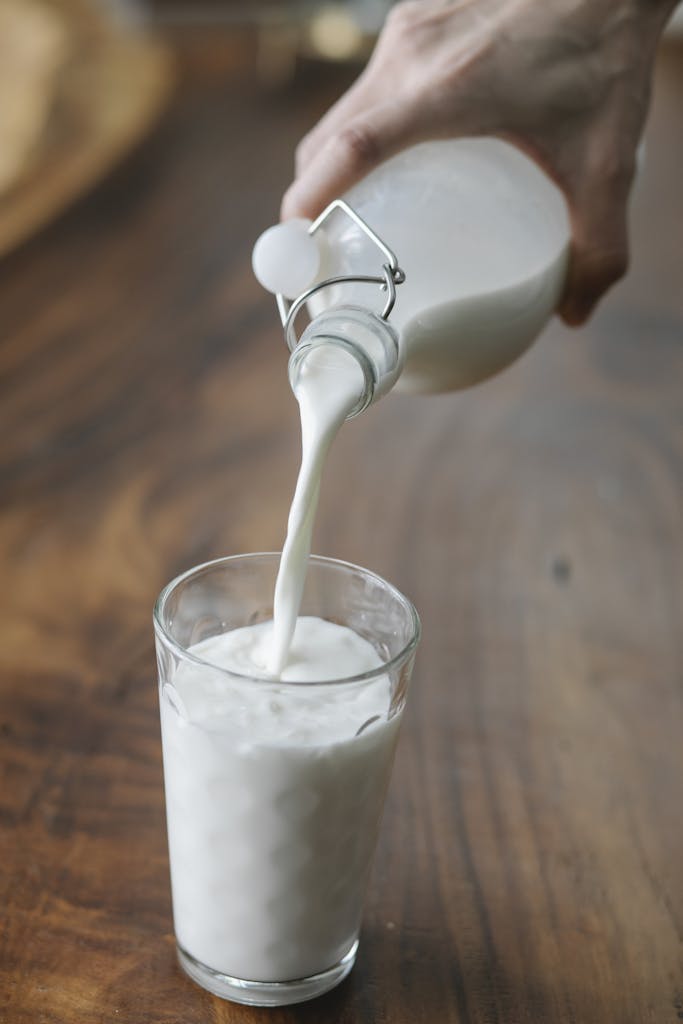The consumption of raw milk in unpasteurized milk has experienced a revival of popularity in recent years. Influencers, politicians and crunchy moms advertise health benefits, but is raw milk safe? Are there any health benefits to drinking raw milk and pasteurized milk? Health officials have been warning us for years of the serious risks associated with consumption of raw milk, making selling raw milk illegal in many areas.
This blog post delves into the trends in raw milk, explores the reasons behind its growing appeal, examines claims from supporters, and highlights the dangers supported by recent scientific research.

Increase in raw milk
Raw milk consumption has shifted from niche practices to a wider movement, captivating a diverse group ranging from health enthusiasts to political conservatives. This change is influenced by some public figures and wellness influencers who advocate for more natural dietary choices. Gwyneth Paltrow, for example, expresses her belief that non-pasteurized milk may be easier to digest, but many acknowledge that such claims are pseudo-science. Still, she claimed she uses raw cream in her coffee every day or on the 2024, terribly named “Skinny Confidential” podcast.


Robert F. Kennedy Jr. advocates for federal legalization of raw milk, saying it is the only milk he drinks. Pastor’s wives, homesteaders, influencers, and anti-comblanic science/medicine people of all sorts jumped on the bandwagon. This trend has always been around, but now it is open.
Science is out. There is a conspiracy theory. What kind of world do we live in?
Who is more likely to drink raw milk?
Certain demographics tend to consume raw milk due to beliefs about health, food purity, and self-sufficiency. These include:
1. Health-conscious consumers
Many raw milk drinkers are looking for untreated organic foods, believing that raw milk provides higher nutritional value and beneficial bacteria that support digestion and immunity.


2. Holistic and Alternative Medicine Advocates
Individuals who follow a holistic health approach often support raw milk and consider it a treatment for allergies, asthma and other illnesses despite the lack of scientific consensus in favour of these claims.
3. Farmers and homesteaders
Many small farmers and homes consume raw milk from cows and goats. They claim that it can ensure cleanliness and quality control and eliminate the need for pasteurization. But even on the cleanest farms, raw milk can contain harmful bacteria that pose serious health risks.


4. Libertarians and advocates of food freedom
Some raw milk advocates view its consumption as a matter of personal choice and resistance to government food regulations. They argue that individuals should have the right to decide what they consume. What is this issue regarding this? Most amateurs are unable to interpret science to determine risk.
5. Parents seeking natural nutrition for their children
Some parents believe that raw milk is a more natural alternative to children, providing essential nutrients without the drawbacks of pasteurization. Interestingly, many of these same parents actively avoid food dyes and other ingredients that are considered “unnatural” while looking down on the scientifically proven dangers of raw milk.
6. Conspiracy theorist and “A worried mother”
There is also a subset of individuals who support alternative theory and reject mainstream food safety recommendations. Many of these individuals refuse to consume artificial food dyes, preservatives, and genetically modified ingredients due to unfounded health concerns, but paradoxically they are willing to consume raw milk, a product known to harbor dangerous pathogens. This contradiction highlights wider distrust of regulators and preference for anecdote over scientific evidence.
How is milk pasteurized?
Pasteurization is a process involving heating milk to a specific temperature for a set period of time to kill harmful bacteria without significantly altering nutritional value. The most common method is:
High Temperature Short Time (HTST) Pasteurization: Milk is heated to at least 161°F (72°C) for 15 seconds, then cooled rapidly. This is the most widely used method for commercial milk production.
Ultra-high temperature (UHT) Pasteurization: Milk is heated to 275°F (135°C) for 2-5 seconds, effectively sterilizes and makes shelf stable without refrigeration until opened.
Low Temperature Long Term (LTLT) Pasteurization: Milk is heated to 145°F (63°C) for 30 minutes. This method is often used in small or specialized dairy products.
Pasteurization significantly reduces the risk of foodborne diseases while maintaining the nutritional content of milk, making it a safer option for consumers.
Is raw milk more nutritious?
Advocates of raw milk consumption argue for several health benefits, including:
Enhanced nutrition profile: Advocates argue that raw milk contains higher levels of vitamins, minerals, enzymes and beneficial bacteria compared to pasteurized milk. They argue that pasteurization reduces these nutrients and reduces the overall health benefits of milk. Raw milk contains no probiotics and contains significantly less nutrients than pasteurized milk. The vitamins, minerals and enzymes in milk are heat-stable and not significantly reduced by the pasteurization process.
Improved digestive health: Some believe that natural enzymes present in raw milk are present in digestion and can alleviate symptoms of lactose intolerance. Raw milk does not contain lactase. This causes the breakdown of lactose in milk. For anyone, including those with lactose intolerance, there is no mechanism by which raw milk can be digested easily.
Immune System Support: It has been suggested that beneficial bacteria in raw milk claims can strengthen the immune system and reduce the incidence of allergies and asthma. once again.


Is raw milk healthy? Science:
These claims have attracted attention, but there is limited scientific evidence to support them.
Nutritional content: Studies show that pasteurization has a minimal effect on milk nutritional value. The difference in vitamin and mineral content between raw and pasteurized milk is negligible.
Digestive System Health: A randomized, controlled pilot study found that raw milk does not reduce symptoms of lactose absorption and intolerance compared to pasteurized milk. Furthermore, enzymes present in raw milk are likely to be broken down by the human digestive system and are ineffective in supporting digestion.
Immune Support: While some observational studies have stated that there is an inverse relationship between raw milk consumption and asthma or allergy, these studies often involve individuals living on farms, making it difficult to isolate raw milk as a protective factor. Furthermore, the potential presence of harmful pathogens in raw milk poses significant health risks outweigh the unproven benefits.
Risks related to raw milk consumption
Consumption of raw milk poses a considerable risk due to the possibility of contamination by harmful pathogens. A 2023 review in the Canadian Infectious Diseases Report revealed that unpasteurized dairy products are 840 times more likely to be diseased than pasteurized dairy products. Similarly, hospitalizations from raw dairy products can be 45 times higher than pasteurized dairy products.
Bacterial Infections: Raw milk can harbor dangerous bacteria such as salmonella, E. coli, Listeria, and Campylobacter. These pathogens can cause severe illnesses, including gastrointestinal distress, kidney failure, and even death.
Foodborne Disease outbreaks: Between 2013 and 2018, 75 outbreaks associated with immature milk caused 675 diseases, with nearly half of cases occurring among individuals aged 0-19.
Antibacterial Resistance: The presence of antibiotic-resistant pathogens in raw milk has led to increased public health concerns as these pathogens can lead to infectious diseases that are difficult to treat.
Recent Concerns – Avian Influenza: In 2024, highly pathogenic avian influenza A (H5N1) virus was detected in raw milk from infected cows. This finding raised an alarm about the possibility of zoonotic infections via raw milk consumption.
Raw milk: Regulatory stance and public health recommendations
Health officials, including the U.S. Food and Drug Administration (FDA) and the Centers for Disease Control and Prevention (CDC), strongly advise against raw milk consumption due to related health risks. Pasteurization processes effectively eliminate harmful pathogens without significantly altering the nutritional content of milk, making disappearing milk a safer choice for consumers.
Currently, raw milk is illegal in 20 states. In 30 states, different regulations are legal for each state.
In short, is raw milk safe?
The appeal of raw milk is rooted in the desire for natural, unprocessed foods, but it is important to recognize the substantial health risks it poses. Scientific evidence does not argue for the health benefits claimed by raw milk advocates. Instead, the research consistently highlights the risks associated with consuming unpasteurized milk. For public health and safety, choose pasteurized dairy products that offer the nutritional benefits of milk without the risk of raw milk consumption.





